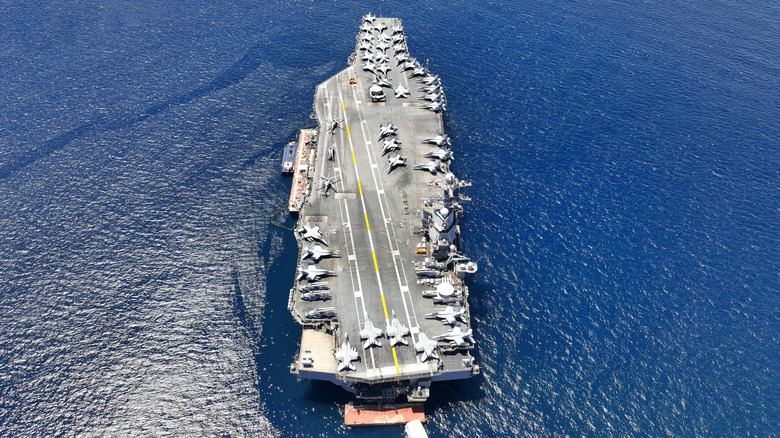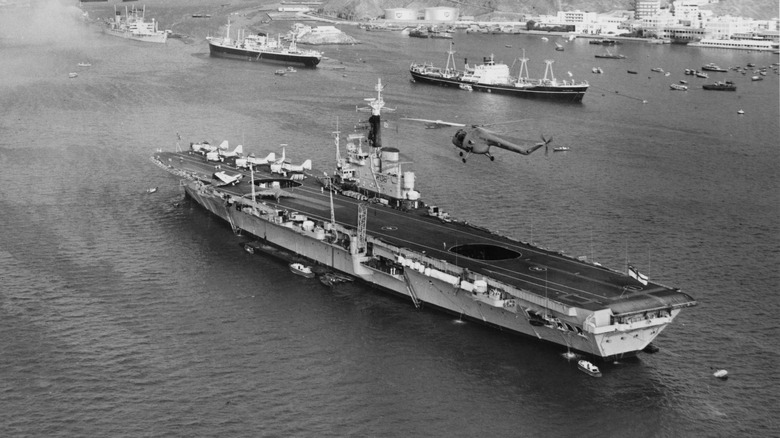Why Are Aircraft Carrier Runways Angled & How Long Are They?
Sometimes called cities at sea or floating airfields, aircraft carriers provide some of the most challenging flight conditions in modern aviation. In addition to a moving runway that may also buck on the waves like a wild bronco, pilots contend with high winds, bad weather, and a short, angled runway.
Aircraft carriers are the backbone of the U.S. Navy. They operate in international waters, allowing the U.S. to easily move planes around the world. They may look massive, but their runways are tiny compared to landing strips firmly planted on the ground. Today's U.S. Navy operates both Nimitz-class and the newer Gerald R. Ford-class carriers. Both classes of ship are about 1,092 feet long, or just about three-and-a-half football fields in length. This may seem like plenty of room in which to land an airplane, but the runway on each ship is only about 300 feet long. By comparison, commercial runways range from 6,000 to 16,000 feet.
The deck of an aircraft carrier is actually home to two runways, one that runs straight down the flight deck and one at a distinct angle. The angled runway is typically used for landing, and allows for simultaneous takeoff and landing operations on the flight deck.
Taking off and landing on an aircraft carrier
You may think you know a lot about aircraft carriers from watching Top Gun, but the new Ford Class carriers are using advanced technology that older carriers don't have. In order to generate enough power to take off from such a short runway, jets need catapults to help launch them. Nimitz Class carriers use the steam catapults you may be familiar with from film and TV. This system has been used for decades, but the new carriers boast electromagnetic catapults. The new system, called EMALS, uses electrical energy from the carrier's engines and turns it into magnetic energy. It's a more efficient and cost-effective system than the old one, and can launch aircraft at over 150 mph.
To land on an aircraft carrier, planes use a hook that extends off of the tail, called a tailhook, to snag an arresting wire that is stretched across the runway. There are typically several wires, in case the pilot misses the one for which they are aiming. Of course, this is a simplified explanation of what is in reality a complicated process, and it takes incredible precision and skill to safely land an aircraft on a carrier. The Ford Class carriers boast a new Advanced Arresting Gear, or AAG, system, that requires less maintenance and allows a wider range of aircraft to land on the carrier.
The history of the angled runway
Early aircraft carriers had only one runway down the center of the flight deck. This meant that only one plane could take off or land at a time, and if a landing plane missed the arresting cable, it could damage the ship or even hit other planes. This could be an expensive and very dangerous mistake for both the pilot and the servicemen on the flight deck.
In 1951, a Captain with the British Royal Navy discovered the key: an angled runway. Setting the runway off at an angle allows planes, which were only getting larger, heavier, and faster in the wake of World War II, to recover after a failed landing attempt. Planes could now regain speed and take off again, rather than crash into the ship or worse, into the water. Angling the runway also provides more space on the flight deck, allowing for two runways and simultaneous takeoff and landing.
The U.S. Navy wasted no time in implementing this new strategy, modifying its existing Essex-class aircraft carrier, the USS Antietam, in 1952. It was the test pilot, so to speak, and was so successful that 14 Essex-class carriers were eventually updated with angled decks.


